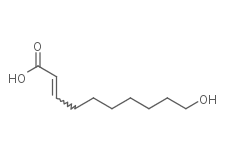
Royal Jelly acid
CAS No. 14113-05-4
Royal Jelly acid( —— )
Catalog No. M18005 CAS No. 14113-05-4
10-Hydroxy-2-decenoic acid is an inhibitor of VEGF-induced angiogenesis, cell migration and proliferation.
10-Hydroxy-2-decenoic acid is an inhibitor of VEGF-induced angiogenesis, cell migration and proliferation.
Purity : >98% (HPLC)
 COA
COA
 Datasheet
Datasheet
 HNMR
HNMR
 HPLC
HPLC
 MSDS
MSDS
 Handing Instructions
Handing Instructions
| Size | Price / USD | Stock | Quantity |
| 50MG | 39 | In Stock |


|
| 100MG | 56 | In Stock |


|
| 500MG | 133 | In Stock |


|
| 1G | Get Quote | In Stock |


|
Biological Information
-
Product NameRoyal Jelly acid
-
NoteResearch use only, not for human use.
-
Brief Description10-Hydroxy-2-decenoic acid is an inhibitor of VEGF-induced angiogenesis, cell migration and proliferation.
-
Description10-Hydroxy-2-decenoic acid is an inhibitor of VEGF-induced angiogenesis, cell migration and proliferation.
-
In Vitro——
-
In Vivo——
-
Synonyms——
-
PathwayMicrobiology/Virology
-
TargetHIV
-
RecptorOthers
-
Research Area——
-
Indication——
Chemical Information
-
CAS Number14113-05-4
-
Formula Weight186.25
-
Molecular FormulaC10H18O3
-
Purity>98% (HPLC)
-
SolubilityIn Vitro:?DMSO : 100 mg/mL (536.91 mM)
-
SMILESC(CCC/C=C/C(=O)O)CCCO
-
Chemical Name——
Shipping & Storage Information
-
Storage(-20℃)
-
ShippingWith Ice Pack
-
Stability≥ 2 years
Reference
1. Yang XH, et al. Comparative proteomic analysis provides insight into 10-hydroxy-2-decenoic acid biosynthesis in honey bee workers. Amino Acids. 2017 Apr 17.
molnova catalog



related products
-
GRL-079
GRL-079 is a novel potent, nonpeptidic HIV-1 protease inhibitor with 2.5-30 nM.
-
Peptide T
Peptide T is an octapeptide from the V2 region of HIV-1 gp120. Peptide T is a synthetic octapeptide whose possible mechanism of action is the competitive inhibition of gp120 to the CD4 receptor as well as binding to vasointestinal peptide receptors and inhibiting cytokine action.
-
I-XW-053
I-XW-053 is an inhibitor of capsid targeted HIV-1 replication using the hybrid structure based method to block the interface between CA N-terminal domains (NTD-NTD interface) with micromolar affinity.



 Cart
Cart
 sales@molnova.com
sales@molnova.com


